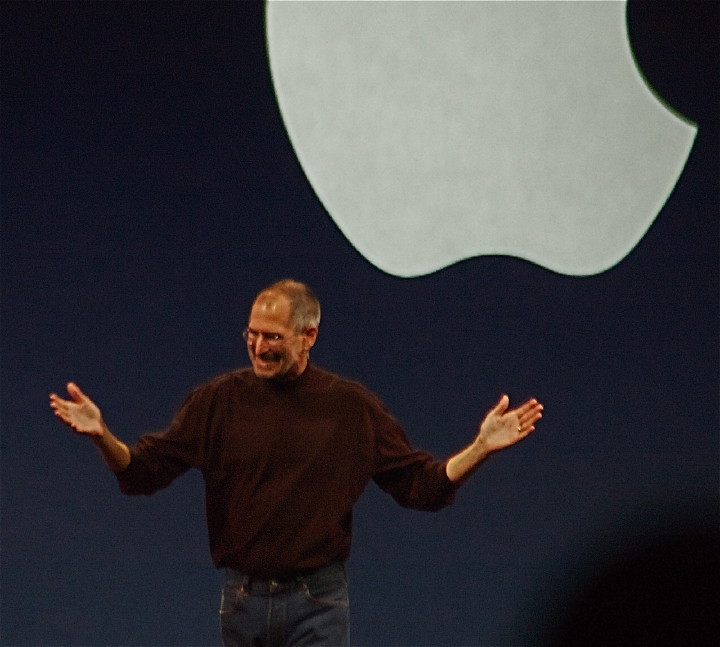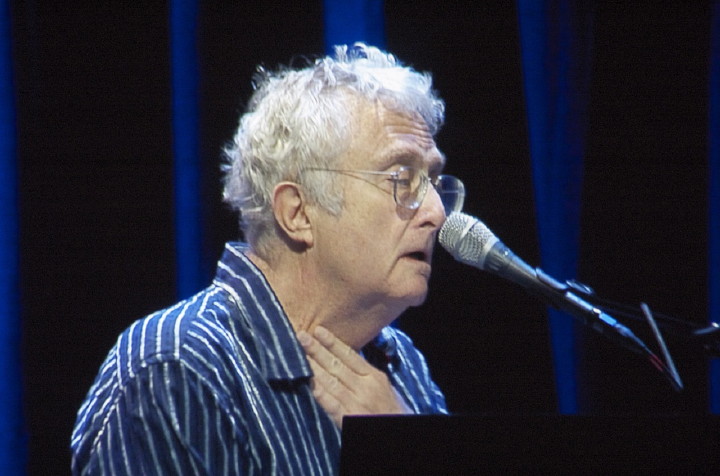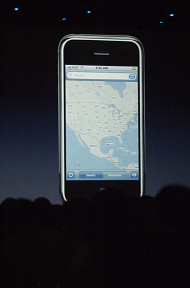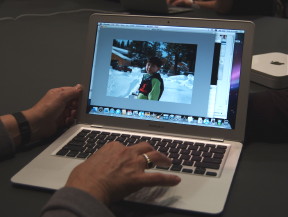|
|

The short answer is, he didn't. A look at the consolidation and expansion that he did display reveals much about Apple's maturity, its future directions and the stability of a company that a few years ago was almost in its death throes.
First, he looked at Leopard. He is claiming that 5 million copies of the new operating system had been sold with a 19% take-up on the user base and then read out positive comments from a number of press sources. Microsoft Office 2008, a native application for the Intel Macs, "the last of the major applications to go native", was now released. Overall, Leopard is a success. He focussed on Time Machine, Leopard's backup feature and announced, "Time Capsule" a backup appliance, which uses an Airport Extreme base station with an added hard disk of either 500 G or 1 Terabyte, priced at $299 or $499 respectively. This will be shipped in February. After an advertisement showing PC and multiple Mac characters, he was done. 10 minutes had elapsed and he moved on to item two, the iPhone, first revealing some of the statistics of take-up.
He moved on to software for the iPhone and confirmed that the Software Developer Kit (SDK) is on track for February as promised, but then moved to new software for the iPhone available immediately, including Maps with Locations; Webclips, Customizable Home Screens and Multiple SMS messages.
The SMS feature for multiple recipients had a warm reception from the audience and Jobs demonstrated how easy this was to do. It reminded me of the simple way that multiple emails can be sent in the OS X Mail application. Using the Safari browser on the iPhone, it is possible to add a web clipping, (with either a site icon, or an icon made from the page itself) to the home page. Added to this, the home page itself can now be altered by the user to match the ways that the individual uses the iPhone (and there were a great number of iPhones being used all around me at the conference). To make the change, Steve pressed one of the icons for a few seconds, then all began to jiggle as if in some coordinated dance routine, to the great amusement of all attending. He was then able to drag each icon to a preferred location anywhere on that page or to one of the other nine pages that are allowed. With movies on the iPhone, it is now possible to navigate through the chapters, to select languages and also, if downloaded, to display the lyrics for any tunes on the phone. These changes were immediately available via a free software update. Jobs ended this part of his presentation with the words, "The iPhone is not standing still." Nor, apparently was the iPod touch. As I complained when I had one on test, with wifi and a browser, it also needed mail. Apple obliged today, but also added the same Maps software as on the iPhone, stocks and weather widgets, notes and webclips. All new iPod touch players will have this immediately, while existing touch users can upgrade for $20. As of this time, there is no information on availability of this download for users in Thailand.
He claimed that, unlike music, people would rather not own a movie, but prefer renting. There will be something like 1,000 available online by the end of February, in the United States both "library titles" ($2.99), by which he seemed to mean older movies that still have popularity, and newer releases ($3.99), which would become available 30 days after the DVD release. International availability will be some time later in the year and more details will be available then, although from a few words I had with an Apple executive afterwards, Thailand is unlikely to be favoured. A user would have 30 days to start viewing the movie, and then 24 hours to finish it then (presumably) it would self-delete or become otherwise unusable, although during that 24 hours, it could be transferred to another device, for example a notebook, iPod or iPhone. In connection with viewing movies, Steve admitted that AppleTV had not been a raging success, but that Apple had examined the weaknesses and AppleTV 2 had been released and it does not need a computer but will allow online linking to media sources, direct from a widescreen television. For those users who have access to such services, they would be able to rent movies directly, and there would now be available High Definition movies ($3.99 and $4.99) with Dolby 5.1 sound. Additionally, as well as audio and video podcasts, there would be photos from Flickr and .Mac as well as some 50 million videos from YouTube, plus iTunes content. The update included a new interface for easier selection of the services. The AppleTV upgrade is free to everyone who already has an AppleTV and he told us that the price has been altered to $229 from $299. A brief and lively presentation was made by Jim Giacopulos, Chairman and CEO of 20th Century Fox who outlined some of the reasons that he and others were moving to such newer business models. In his comments he seemed to be endorsing Blu-Ray and also mentioned that DVDs were now able to be copied to computers.
While a Sony has a width of 1.2" tapering to 0.8", the new Mac starts at 0.76 and tapers to an almost unbelieveable 0.16". Its weight is 3lbs (1.36Kg) and it will fit in a document envelope: and that is how Steve Jobs displayed the first one -- out of an envelope. The LED backlit display is 13.3" with "instant on" and the surround contains an iSight camera. The MacBookAir is fitted with a full size keyboard which, like current Macs has the ambient light sensor. While current Macs have some multi-touch screen gestures available, there are more with the Air, including rotation of photographs, panning (using three fingers), and the "pinch", for zooming.
To add to the small profile, ports are concealed in a housing: headphones, USB and mini DVD connector. The Air comes with 802.11n wifi as standard and Bluetooth 2.1 (+EDR), but has no optical drive. Instead updates may be made with "Remote Disk" software installed on another computer (Mac or PC) which links the two computers. Jobs said, "We don't think users are going to miss the CD drive." There is available an optical drive as an accessory for some $99. The MacBookAir is priced at $1799 and is expected to be available in two weeks in most countries where Macs are sold. Steve Jobs began to wind down and first outlined the improvements to environmental acceptance and recycling that Apple was bringing in, then reviewed 2008 (only two weeks) adding, "We've got 50 more weeks to go." The Keynote proceedings ended with a performance of two songs by Randy Newman, the first of which was an overtly political tune which was entusiastically accepted. He had almost as much applause as Steve himself.

|
|
 The iPhone does not use GPS but makes use of input from two sources: Google and Skybook. While Google uses triangulation with input from cell phone masts, Skybook has mapped over 23 million wifi hotspots round the world and again triangulates a position from these inputs. Apple uses both and it is possible for users to identify their locations and a pin is displayed on screen. Other pins may be used as destinations and any such pin can be added as a locator bookmark.
The iPhone does not use GPS but makes use of input from two sources: Google and Skybook. While Google uses triangulation with input from cell phone masts, Skybook has mapped over 23 million wifi hotspots round the world and again triangulates a position from these inputs. Apple uses both and it is possible for users to identify their locations and a pin is displayed on screen. Other pins may be used as destinations and any such pin can be added as a locator bookmark. There are a number of reasons for the reduction in size, including the use of 1.8" hard disk (80G standard with 64G solid state option) and miniaturised electronics, including a smaller size Intel Core 2 Duo processor which is 60% smaller. The chip comes with 1.6GHz as standard and a 1.8 option. This new computer has 2G RAM as standard and battery life is a useful 5 hours.
There are a number of reasons for the reduction in size, including the use of 1.8" hard disk (80G standard with 64G solid state option) and miniaturised electronics, including a smaller size Intel Core 2 Duo processor which is 60% smaller. The chip comes with 1.6GHz as standard and a 1.8 option. This new computer has 2G RAM as standard and battery life is a useful 5 hours.